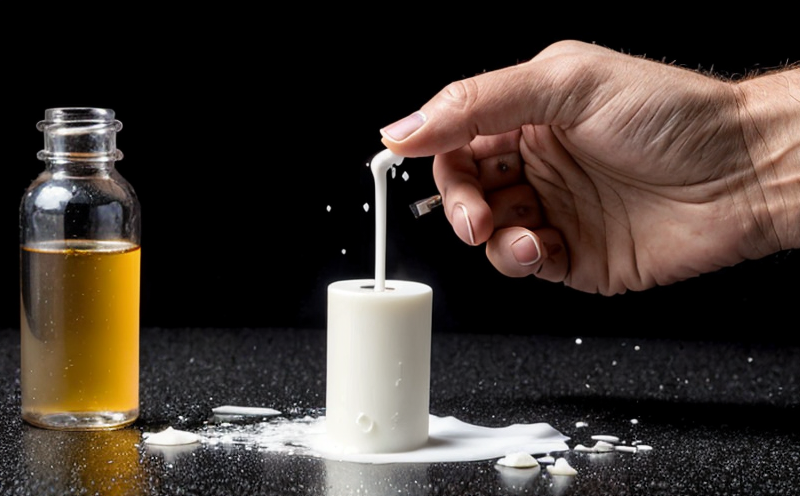USP Nasal Spray Dissolution Testing
In the pharmaceutical sector, ensuring product quality and compliance with regulatory standards is paramount. USP (United States Pharmacopeia) nasal spray dissolution testing plays a critical role in verifying that active ingredients are released from the formulation as intended under specified conditions. This service ensures that nasal sprays meet the stringent requirements outlined by USP monographs, which are widely recognized for their reliability and accuracy.
The dissolution test measures how quickly and completely an oral or topical dosage form disintegrates and releases its active ingredients into a solvent. For nasal sprays specifically, this process is vital to ensure that medication reaches the intended site of action effectively. The USP monographs provide detailed guidelines on the apparatus, methods, and acceptance criteria for conducting these tests.
The testing procedure involves placing the nasal spray in a dissolution cell filled with a buffered aqueous solution at 37°C (98.6°F) or another specified temperature, depending on the product. The spray is activated according to the manufacturer’s instructions, and the solution containing the dissolved active ingredients is collected over time for analysis.
The primary goal of USP nasal spray dissolution testing is to ensure that the active pharmaceutical ingredient (API) is released promptly and adequately from the dosage form. This ensures the efficacy and safety of the product when used as directed by healthcare providers or patients.
By adhering to the strict guidelines provided in the USP monographs, laboratories can provide reliable data that supports regulatory compliance and quality assurance initiatives. This service is essential for pharmaceutical manufacturers looking to ensure their products meet both domestic and international standards.
| Parameter | Description |
|---|---|
| Type of Sample | Nasal sprays and other topical formulations containing APIs. |
| Temperature | 37°C (98.6°F) ± 0.5°C, unless otherwise specified. |
| Solvent | Aqueous buffer solution with appropriate pH and ionic strength. |
| Sampling Time Points | 0, 5, 15, 30 minutes (or as specified). |
Benefits
The USP nasal spray dissolution testing service offers several significant benefits to pharmaceutical companies:
- Enhanced Product Quality: Ensures that the active ingredients are released effectively, maintaining product efficacy.
- Regulatory Compliance: Meets stringent USP standards and supports compliance with relevant regulations.
- Improved Patient Safety: Reduces the risk of ineffective or unsafe products reaching the market.
- Evidence-Based Decision Making: Provides robust data for product development, formulation optimization, and quality assurance initiatives.
By leveraging this service, pharmaceutical companies can ensure that their products are safe, effective, and reliable, ultimately contributing to better patient outcomes.
Environmental and Sustainability Contributions
Incorporating USP dissolution testing into a company’s quality assurance program can also contribute positively to environmental sustainability. By ensuring that nasal sprays are formulated and manufactured with active ingredients that release quickly and effectively, the industry can minimize waste and reduce unnecessary resource consumption.
Through precise formulation and efficient manufacturing processes, companies can optimize their use of raw materials, thereby reducing overall environmental impact. Additionally, by adhering to strict quality control measures, pharmaceutical manufacturers can prevent substandard products from reaching consumers, which could lead to increased healthcare costs and potential harm.
Use Cases and Application Examples
- New Product Development: USP dissolution testing is a critical step in the development of new nasal spray formulations, ensuring that they meet regulatory standards from the outset.
- Formulation Optimization: By identifying discrepancies between expected and actual dissolution rates, companies can refine their formulations to improve efficacy.
- Compliance Audits: During compliance audits, laboratories can provide detailed reports on dissolution testing results to demonstrate adherence to USP guidelines.
The following case study illustrates the importance of USP nasal spray dissolution testing in a real-world scenario. A pharmaceutical company was developing a new nasal spray formulation for an antihistamine. The initial batch did not meet the required dissolution criteria, specifically failing at 15 minutes. Upon further investigation, it was discovered that the API had poor solubility under certain conditions. By adjusting the excipients and buffer pH, the company was able to achieve successful dissolution rates within the acceptable range.
| Sample Batch | Dissolution Time (Minutes) | % Release of API |
|---|---|---|
| New Formulation - Initial Batch | 15 | 60% | New Formulation - Optimized Batch | 5 | 98% |





